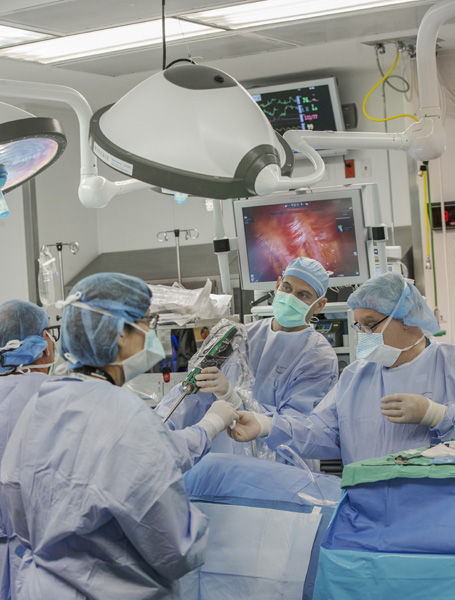Lung cancer is the most deadly cancer in the United States. The American Cancer Society estimates some 221,200 new cases will be detected in 2015 and another 158,040 Americans will die from the disease this year alone. That’s the entire population of Indian River County plus an additional 16,000 lives.
The disease is a near-equal opportunity killer – 86,380 of those deaths will be men and 71,660 will be women. Put another way, this year, more people will die from lung cancer than colon cancer, breast cancer and prostate cancer combined.
Despite the numbers, above, however there actually is some good news in the fight against lung cancer. If caught early, a diagnosis of lung cancer no longer need be a death sentence.
Today, with CT scans, biopsies and electromagnetic navigational bronchoscopy exams, physicians like Dr. Mark Malias, a cardiothoracic surgeon at Indian River Medical Center, can detect cancer cells deep within the lung much earlier than was possible just a few years ago. Once cancer is detected, there are multiple treatment options, including radiation therapy, chemotherapy and surgery.
If surgery is the best option it is comforting to know today’s doctors have surgical techniques that would make Evarts Graham green with envy. Graham, a surgeon in St. Louis, MO, conducted the world’s first successful cancer pneumonectomy – the removal of part of a lung – back in 1933 with what today’s physicians would call the most rudimentary of equipment.
The newest and quite probably the most misunderstood of today’s surgical options is the da Vinci surgical system. Named for the 15th century inventor, artist and philosopher, Leonardo da Vinci, the use of this four-armed amalgamation of digital, optical and surgical know-how is now commonly referred to “robotic surgery” – though it is not actually a medical procedure performed by R2-D2, Robbie the Robot or any other nuts and bolts character from science fiction.
Robotic surgery is, instead, the most up-to-date type of “minimally invasive” surgical technique. Approved by the FDA for both adult and pediatric surgeries, it has already proved itself in neurological, urological, gynecological and dozens of other general surgical procedures. Now, Malias and others worldwide are using the da Vinci system to take on lung cancer.
The da Vinci ® system consists of three separate units. There is a surgeon’s control console, an image processing console and the surgical section itself with its four long mechanical arms: one for a high-definition 3-D camera and three for various miniaturized surgical tools.
The surgeon makes three-to-six dime-sized incisions called “operating ports” along the side of the patient’s chest. Small tubes or “trocars” are then placed into those ports to allow the passage of the camera and surgical tools. Using foot pedals and hand controls, the surgeon manipulates the robotic arms, making the instruments twist, turn and rotate to cut tissue, remove tumors or lymph nodes and then sew the incisions closed.
It might be fair to ask, “What’s so minimally invasive about that?” Well, for starters, there’s a lot less cutting going on.
In a traditional thoracotomy, (a surgical incision of the chest wall), an incision is made on the front of the chest under the nipple line which then extends all the way around the back under the shoulder blade. “Those incisions,” explains Malias, “are 16-20 centimeters long” and sometimes even longer. In the da Vinci or robotic procedure, Malias continues, “the incisions are only one to three centimeters long.”
Moreover, in a traditional thoracotomy, the surgeon will cut a rib and then slide that rib over a lower rib in order to gain access to the lung. The cutting and sliding of rib bones is not necessary with the da Vinci system.
“It allows me to perform surgery through a few tiny incisions between the ribs,” Malias says. He quickly points out that he is fully capable of performing the traditional surgery saying, “I’ve been fortunate enough to be trained in both heart and lung surgeries,” but now that he is also an expert in the da Vinci system he says he’s “a minimally invasive surgeon” whenever he can be.
That’s a telling comment from a doctor with well over 25 years of surgical experience who also happens to have garnered the maximum five-star patient recommendation ratings from vitals.com, healthgrades.com and UCompareHealthCare.com.
For some people, though, the word “robotic” still raises eyebrows. While the Baltimore Sun reports that the da Vinci’s state-of-the-art technologies “scale, filter and seamlessly translate the surgeon’s hand movements into precise micro-movements” and flatly states that the system “cannot be programmed and it cannot make decisions on its own and requires that every surgical maneuver be performed with direct input from a trained surgeon,” some people still perceive this to somehow be an automated procedure.
Tampa’s Moffitt Cancer Center forcefully rebuts that perception. “At no point does the system automate any of the steps in your surgery or make decisions without the direct input of your surgeon,” the center states, adding that, “the platform allows your surgeon to perform your entire surgery through several small incisions in your chest with a level of precision that simply can’t be replicated without robotic assistance.”
Lung cancer surgeries performed using the da Vinci system offer several other benefits over traditional surgeries, including lower rates of complications, less blood loss, shorter hospital stays and less post-operative pain and discomfort. In fact, Malias says his da Vinci patients, “want to know when they can get back to playing golf” much sooner than those who undergo more traditional surgeries.
The biggest drawback to the da Vinci system may be that not everyone is a viable candidate for it. Patients, for example, who have undergone previous radiation treatments, have mobility issues or aren’t able to tolerate the gasses used to inflate the lung during surgery are likely not suited for da Vinci procedures. And, as with any surgery, there are still risks that should be discussed in detail with your physician before any decision is made.

